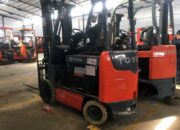Important Considerations When Choosing Forklifts for Your Warehouse
In today’s manufacturing and logistics environment, selecting the right forklift is crucial for optimizing both performance and safety in your facility. This article aims to guide warehouse owners and technical managers through the key factors to consider when making a forklift purchase decision.
Assessing Your Forklift Needs
Before diving into technical specifications, the first step is to accurately determine your forklift requirements within your facility.
– Evaluate Load Volume: Identify the average and maximum weights of the goods you need to lift. This will help you select a forklift with appropriate lifting capacity, avoiding the pitfalls of purchasing one that is either overpowered (wasting resources) or underpowered (failing to meet demands).
– Consider Dimensions and Types of Goods: If your goods are oversized (too long or wide) or irregularly shaped, you may need a forklift with specialized design features or suitable attachments.
– Analyze Your Work Environment: Determine whether the forklift will primarily operate indoors or outdoors. This choice impacts your selection of tire type and power source.
Common Types of Forklifts Used in Warehouses
Understanding the various types of forklifts available will help you make an informed choice that best meets your warehouse needs.
– Electric Forklifts: Ideal for indoor environments, they operate quietly and produce no emissions. However, charging times can affect continuous operation.
– Internal Combustion Forklifts (Diesel, Gas): Suitable for outdoor use, these forklifts can lift heavy loads and run continuously. However, they do emit exhaust and generate noise.
– Lithium-Ion Battery Forklifts: This newer technology combines the benefits of electric forklifts (clean operation, quiet) with faster charging times and longer battery life.
– Pros and Cons of Each Type: For instance, electric forklifts have lower operating costs but require a higher initial investment. Diesel models offer greater power but come with higher fuel and maintenance costs.
Technical Factors to Consider
Once you’ve identified the appropriate type of forklift, delve into its technical specifications to ensure it meets your operational needs.
– Lifting Capacity and Height: Ensure that the forklift can handle the maximum weight of your goods while reaching necessary heights within your warehouse.
– Turning Radius: This is critical in tight working spaces. A smaller turning radius allows for greater maneuverability in narrow aisles.
– Travel Speed and Lifting Rate: Balance speed with safety; faster forklifts can enhance productivity but may pose more risks in crowded environments.
– Braking System and Stability: Confirm that the forklift can stop safely when fully loaded and maintains high stability when lifting at significant heights.
Economic Considerations & Long-Term Costs
Purchasing a forklift involves not just upfront costs but also long-term investments.
– Initial Purchase Price: Compare prices from different manufacturers while considering product quality and reliability.
– Operating Costs: Calculate fuel or electricity expenses based on projected usage over time.
– Maintenance & Repair Costs: Simpler designs often incur lower maintenance costs. Research frequency and costs associated with routine servicing.
– Expected Lifespan: A more expensive model may offer a longer lifespan, ultimately saving money over time.
Safety & Ergonomics
Safety should always be a top priority. When selecting a forklift, pay attention to:
– Safety Features: Look for features such as anti-tip systems, warning lights, reverse alarms, and safety locks.
– Cab Design & Visibility: A spacious cabin enhances operator comfort while good visibility from the driver’s seat is essential for safe operation.
– Safety Standards & Certifications: Ensure that the forklift complies with international safety standards and has appropriate certifications.
Flexibility & Application Versatility
Manufacturing environments are ever-changing; thus adaptability in a forklift is vital:
– Adaptability to Different Goods Types: Choose a model capable of handling various types of loads for increased operational flexibility.
– Compatibility with Attachments: A forklift that can accommodate attachments like paper roll clamps or pallet rotators expands its functionality.
– Upgrade Potential: Consider whether future upgrades are possible—such as increasing lifting height or changing power sources.
After-Sales Services & Technical Support
Post-purchase support can significantly influence long-term effectiveness:
– Warranty Terms: Investigate warranty duration and coverage details. Some manufacturers offer extended warranties or hour-based guarantees.
– Availability of Spare Parts: Ensure that replacement parts are readily available to minimize downtime during repairs.
– Operator Training & Maintenance Support: Many suppliers provide training programs for operators and technicians which help optimize performance while extending equipment lifespan.
Additional Considerations When Selecting Forklifts for Your Warehouse
If possible:
- Conduct trials before purchasing to assess performance firsthand,
- Consult industry experts,
- Gather feedback from current users about their experiences,
- Review any additional features that might enhance efficiency specific to your operations.
By carefully considering these factors when choosing a forklift for your warehouse, you’ll be better equipped to make an informed decision that enhances productivity while ensuring safety in your operations.







